 Gnostic Anthropology
Gnostic Anthropology  Norse Myths and Legends
Norse Myths and Legends

|

|
| Written by Editor VOPUS | ||||||||||||||||||||||||||||||||||||
NORSE MYTHOLOGYNorse Myths and Legends1.- INTRODUCTION AND
|
||||||||||||||||||||||||||||||||||||
| I could sing | my own story, |
| talk about my travels | and how much I suffered |
| from hard sailing times | and days of great toil; |
| Often bitter shortcomings | while in different ports |
| And I've often learned | what an awful home, |
| a boat caught in the storm makes; | When came my turn to guard |
| into the tough night | at the bow of the ship |
| I used to see rocks passing by. | Often my legs |
| were petrified by frost | in my ice-cold shoes |
| Tormented by cold, | transfixed by fear |
| With a sad heart, | seeking help |
| My tired sailor mind... | And yet once more |
| The blood from my heart | once again |
| urges me to try | Salty waves are playing; |
| The sea resembles a mountain, | and, persistently asks it again |
| The impulse of my heart | to visit distant lands. |
| To start a new journey | on faraway seas... |
(The Sailor: Exter Book)
(The poem is read as it makes sense, i.e., first row on the left and then that of the right column. It is written in this form to comply with the original, because this is the way they wrote in ancient Norse language.)
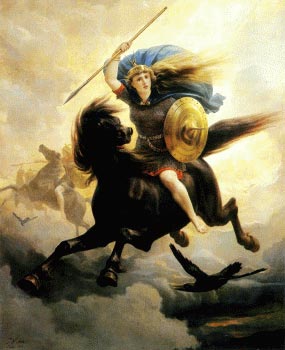
On the other hand, the myths and legends on which their culture is based upon have a so heroic, warrior like character and filled with great adventure, that for an "exoteric" type of reading, they obviously push toward adventure and conquest: and so they end up attacking the main cities of England, north Germany, Paris; there are reports of an attack even upon Seville, where they were dismissed by the walls present by then in Spain (we must also say that many historians are beginning to believe that these reports, that describe their attacks, exist rather as legend than as real facts).
There is no doubt that their myths, filled with such an extraordinary heroic and warrior like character, had to be understood in an esoteric form, as the path of the warrior in his fight against himself. But as it happens these very degenerate days, only a few were capable of reading the occult message.
However, each time more and more historians agree that the Viking people were cultivated and knew and loved to listen to these myths, there was something of high value in them, as well poetry and mystery...
It's not easy to determine the origin of these myths and legends. Because they were transmitted orally from generation to generation, any data that current science assigns to them (involving centuries VIII or IX) is only mere speculation.
Today, in the light of Gnosis, we can say that their origin is immersed in the frightening night of the centuries, their roots come from the North Sacred Island, the mysterious Thule, situated in the place where today lies the Arctic Pole, from a remote past, that the Hyperborean Race lived in.
Since then, the wisdom of those occult Gods passed in the form of myths and legends from race to race, from generation to generation, until they reached the current epoch.
Around the tenth century, Irish monks, who moved to Iceland to seek solitude and recollection, come into contact with the Vikings, who begin to establish colonies in Iceland, and reap in written some of the heathen poems which circulated among the Vikings.
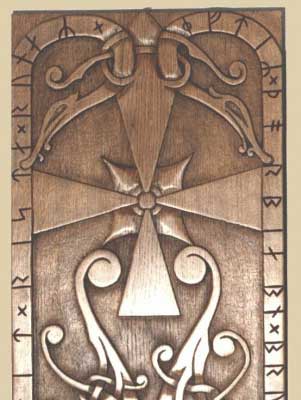
Thus, almost all that exists currently about Norse mythology comes from Iceland.
This material is divided into two groups: Edda (on whose meaning researchers do not agree, but we can afford to suggest that it may derive from the root "Ed" which means "solemn act, oath") and Skaldice poems (from Norwegian old "Skáld", "poet").
Edda consists of two manuscripts: The first, called "Codex Regius", consisting of 29 complete or fragmented poems and are kept in Copenhagen (Denmark) until 1971, when it was returned to Iceland. The second, consisting of seven poems, one of which is not included in the Codex Regius. These poems include religious myths, stories of old heroes and tips for everyday life. Some examples would be Völuspá (which means "Sibyl prophecies"), Hávamál ("Words of the Almighty"), etc.
The Skaldic poems such as "The Sailor", shown above, on the contrary include historical events, stories of daily life, the succession of kings, battles, etc.
Last but not least, are "saga" (stories) in prose, most of them associated to a Governor and thirteenth century Icelandic poet called Snorri Sturluson, which grouped in the so-called "saga", among others, clarifications and explanations about Edda poems which were very helpful to better understand these myths.
When one studies the Edda, realizes that the esoteric tradition of The Norsemen was deep and very rich, but, unfortunately, much has been lost. Some poems with esoteric content are incomplete and mixed with many pieces unrelated to divinity. Thus, for example, Hávamál ("Words of the Almighty") there is only a small piece of text with a deep esoteric content (shown below), which undoubtedly was part of a much larger text. The other part of Hávamál shows tips on daily life, but without any special transcendence.
However, what has arrived to us is enough for our thirsty of wisdom soul to be able to enjoy "The Words of the Almighty".
Thus begins the myth of creation in Völuspá (Sybil's Prophecies):

I hear and see sacred people
Large and small, in the kingdom of Hemidal (guardian of the holy place of Gods)
You're asking me, Valford (father of warriors, which is another name for Odin), that I tell you
the old legends of the people
who dwell in the depths of my memory.
The world has started with a golden era,
I still remember the giants born at the beginning of time,
Which gave me life in those distant times,
Nine Worlds I remember, nine roots of the tree of power
(he was referring to Yggdrasil, the cosmic tree)
That sustained the worlds, and also the worlds from the depths of the Earth.
At the beginning of time there was nothing;
No sand, nor sea, nor cold waves,
There was no land, nor the high heavens,
Just a big void; rose from nothing,
Until the sons of Bur (Gods) raised the lands,
And created the Middle Land (physical world), an unparalleled place.
From South did the Sun glisten above a world of stones.
Grass started growing and fields became green.
The Aesirii (one of the nations of Gods) gathered in Idavoll
had risen haughty temples and shrines,
and established forges for making precious treasures,
also invented pliers and tools (to work in forges).
* * * * *
The lyrics continue to speak about creation. But we will be making a brief summary, with the help of other poem's stories:
In the beginning there was only a big void, called "GINNUNGAGAP", and "YGGDRASI", the cosmic tree that sustained the worlds. At the roots of this tree there were two kingdoms, one of fire, called MUSPELL, and another of darkness and fog, called NIFELHEIM. Between the two kingdoms there was HVERGELMIR, a large cauldron of boiling water, that fed the twelve rivers that floated above the great abyss, "GINNUNGAGAP" and which by falling in it, formed giant blocks of ice (this is the original "chaos" of all great primitive religions).
At the dawn of existence, flames of fire from the kingdom of MUSPELL fall over the blocks of ice, forming giant clouds of steam coming out of the great void, forming the elements, space and a large ocean and the land, initially frozen (we see here the fire fertilizing the waters, origins of the worlds, beasts, men and Gods).
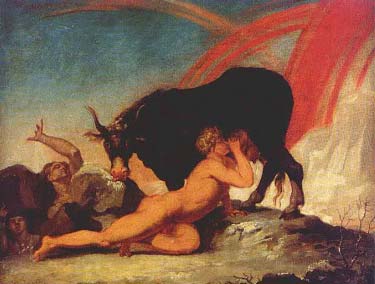
Then comes into being the "AUDHUMLA" Cow (Mother Space). She begins to lick and to melt the ice, freeing the giant BUR, then from the droplets of melted ice formed the giant YMIR made of ice (Divine androgynous beings, which appear from the absolute in the dawn of creation), which she feeds with four rivers of milk that come out of her udder.
Then worlds appear sustained by the holly YGGDRASIL, tree of life that sustains the nine worlds (superior dimensions), MIDGARD (land of people or physical world) and NILFLHEIM (worlds of hell or infradimensions). These worlds were sustained by its branches and three of its roots communicated. This is the tree of Kabbalah with its Sephiroth and Worlds of Hell.
From the union of BOR (BUR's brother) with a giant the Gods appear. The first Gods are ODIN, VILI and VE.
From this point on, there are two versions:
One says that the giant YMIR falls asleep and from his left arm's armpit sweat drops fall and the first human pair is formed, ASK and EMBLA (Adam and Eve). But the giant Ymir himself bears the seeds of evil (ego) and his descendants will be "ice giants", the incarnation of evil, of the Ego, of the angelic fall, starting from that moment on a life and death struggle between the Gods and ice giants (which will be the center of any Norse epic until the final outcome of the RAGNAROK).
Odin, Vili and Ve kill the giant YMIR and create the Earth, as "Vafprúonismál" tells us (in Vafthrudnir's Stories):
From Ymir's flesh the earth was created
and from his bones, the stones,
the sky vault was built from the ice giant's skull,
and the sea formed from his blood.
* * * * *
Then, the first human pair is formed from a piece of wood; Odin gave them life with his breath, Ve gave them their senses and Vili gave them intelligence.
So far, in summary form, Creation is presented. From here on poems continue, as I said, with the struggle between Gods and giants of ice, the incarnation of evil.
We can see certain parallels between these stories, related to Creation and the biblical genesis, and to the Jewish Kabbalah or the Mesopotamian stories of creation that is realized through fire and water, pointing us towards the same truth that emanates from the Norse stories, namely: creation is pure sexual alchemy...
Gods resided in ASGARD (the higher worlds, the heavens), which was merged with MIDGARD (physical world) through a rainbow of fire, guarded by the God HEMIDALL.
They lived happily and ate "apples of youth", cultivated and guarded by Goddess IDUN, and thanks to them always remained young and full of vitality.
But in Asgard were many lands and there were two types of Gods, among which conflicts came to be born; although, after all, they live in harmony with each other: the warrior type AESIRII who lived in VALHALLA and whose chief was ODIN and the VANIRII (of lower nature, the Gods of fertility, of nature, etc..), which lived in VANAHEIM.
This difference between Gods is unique (it isn't found in any other theogony), the distinction that is made is between Gods of the Direct Path and Nirvanic Gods. The Norse epic foreground is rather occupied by the Aesiri than the Vaniri, very clearly indicating that Norse mythology is an esoteric teaching of the Direct Path...

ODIN, KETHER of KABBALAH, also known as Woden or Wotan, is the "Father of the Gods", was known as "Lord of (inner) War" and the Father of the "glorious dead" (dead concerning their psychological defects). Valhalla was his residence and from his throne the nine worlds could be contemplated. Two birds (Ravens) accompanied him and informed him of everything that was going on in the nine worlds.
He was also the wisest of the Gods, but it was not easy for him to obtain wisdom. In many engravings he is represented with a single eye. Let’s find out, by knowing his story:
Since he was born he wanted to achieve Wisdom, and looking for it, he found that beneath the roots of the sacred tree (Yggdrasil) there was a well whose water gave Wisdom. This well was guarded by Mimir's head, a goddess who was beheaded. By going down this well, beneath the roots of the great tree (i.e. descended into the ninth sphere), met with Mimir's head (psychological decapitation) which forced him to give one of his eyes (sacrifice) to let them drink from the well of Wisdom.
Odin doesn't hesitate and sacrifices one of his eyes to be able to drink from the fountain of wisdom. He discovers ineffable things and obtains Wisdom (Mastery), but he needs more: to obtain power over life and death (Christification)...
I know I was hanging from that tree in the wind,
I had swayed over nine long nights,
wounded by my own sword edge,
shedding my blood for Odin,
myself being an offering to myself:
tied up to that tree whose roots no one knows where they sank.
Nobody gave me anything to eat,
nobody gave me anything to drink.
I contemplated the deep abyss
until the Runes came up.
With a cry of anger I got a hang of them,
and then I fell fainted.
Nine terrible songs
of the glorious son of Bolthor I learned
and got a mouthful of the glorious wine (*)
served by Odrerir.
I had obtained welfare
and also wisdom.
I jumped from one word to another
and from one act to another
(Words of God Almighty: Hávamál)
(*) By wine we've translated, "Mead", an alcoholic drink much appreciated by the Vikings.
In this story Odin is hanging by the Yggdrasil tree, wounded to death; by voluntary sacrifice he resurrected, then, full of power and wisdom. After this experience, legend says, he gets the power over life and death.
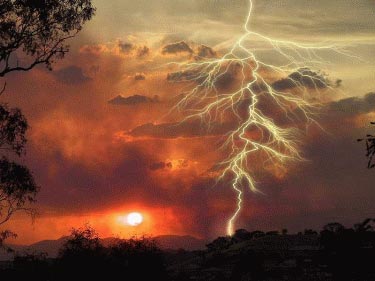
This story has surprised researchers because of their similarity with the crucifixion of Jesus Christ. In addition, as V.M. states Samael Aun Weor, Jesus' life exemplifies symbolically the Christification processes through which any Initiated must pass to obtain the Resurrection of Christ's inside his heart.
So it's normal to encounter such a story in a teaching of the direct Path, which comes from Hyperborean race, during which, in ancient times, the great masters of this Maha-manvantara were embodied.
This story is part of a larger one that certainly had a great initiatic value, but, unfortunately, was lost over the centuries.
Afterwards, there are many battles that Odin has to fight, with his magic sword, against the giants of ice. Furthermore, knowing the fate that awaits the Gods, he reunites in Valhalla the souls of the heroes who died in battle, to form an army waiting for the final battle of Ragnarok.
This story shows that the Vikings were very brave, because they had faith that if they died heroically in battle they will go to Valhalla (the residence of the Gods), to be part of Odin's army.
In this presentation we won't be talking on the issue of the Rune cited in the poem above, because it would take up too much space. We recommend the reader the interesting book of "Runic Magic" of V.M. Samael Aun Weor.
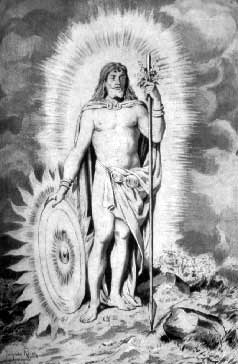
Balder is the Christ in Norse Mythology, Odin's son and FORSETI'S Father (God of Justice).
Legend tells that as a young boy he suffered from terrible nightmares that predicted its death. Then his Mother decides to do something about it. She crosses the nine worlds and asks all living beings, animals, plants and minerals to promise that they will not ever harm Balder. All living things make this oath, except the mistletoe. His mother doesn't give any importance to it and she believes she has solved the problem.
This way, Balder becomes immortal. Gods of Valhalla are having fun throwing arrows, causing him not even the slightest injury.
But LOKI, the God of fire, betrays the Gods; he tricks the blind God HODR by giving him an arrow whose tip had a mistletoe plant. The blind God shoots at Balder and he falls wounded to death.
We see here, in this passage, how the God of Fire, betraying the Gods (fornication) murders the Intimate Christ in us, this is also found in other esoteric teachings: Seth murdered Osiris, Hiram Abiff is killed by three traitors etc.
While Balder is dying, Odin whispers something to his ear. Nobody knows what he said, but legend tells that he promised the Resurrection that will result from the purification of the world after the Ragnarok disaster.
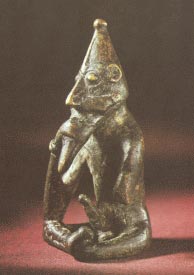
The name "Freyr" and that of his twin sister "Freyja" means "Lord" and "Lady". They are the Lord and Lady of the worlds, the fire that burns inside all things, they represent the Third Logos, and are identical to Hindustani Shiva-Shakti.
Freyr was one of the most worshiped Gods, besides Odin and Thor. Together with Freyja represented fertility and had control over the land, the rain, fecundity and peace.
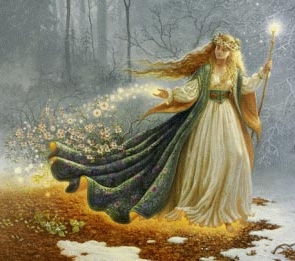
In the temple of Uppsala (Sweden) there is a statue, founded in the year 1200, depicting this God, which is represented with a triangular head, a large tongue (verb) and a large phallus in erection...
Freyja, on the other hand, was the Goddess of love and voluptuousness, the Devi Kundalini, and crossed the heavens in search of her lover, in a chariot drawn by cats, and in the company of love spirits like Cupid.

Of course not all Vikings were adventurers, travelers and warriors. There were also farmers, land and family lovers.
As the first had a predilection for ODIN, which they called "Father of War", the latter preferred THOR for his good and noble character.
Thor was Odin's son, just like Balder, and he was highly revered. He was the God of thunder and lightning and was liken to Zeus-Jupiter, he was so important that, when the Anglo-Saxons adopted the Roman calendar, they named the fifth day of the week, Thursday (Jupiter's day), "Torsdag" (Thor's day) in Swedish.


| < The Sphinx comes from Atlantis | The Palette of Narmer > |
|---|
| Science |
| Art |
| Philosophy |
| Mysticism/Religion |
| Barbelo: Gnosis Magazine |